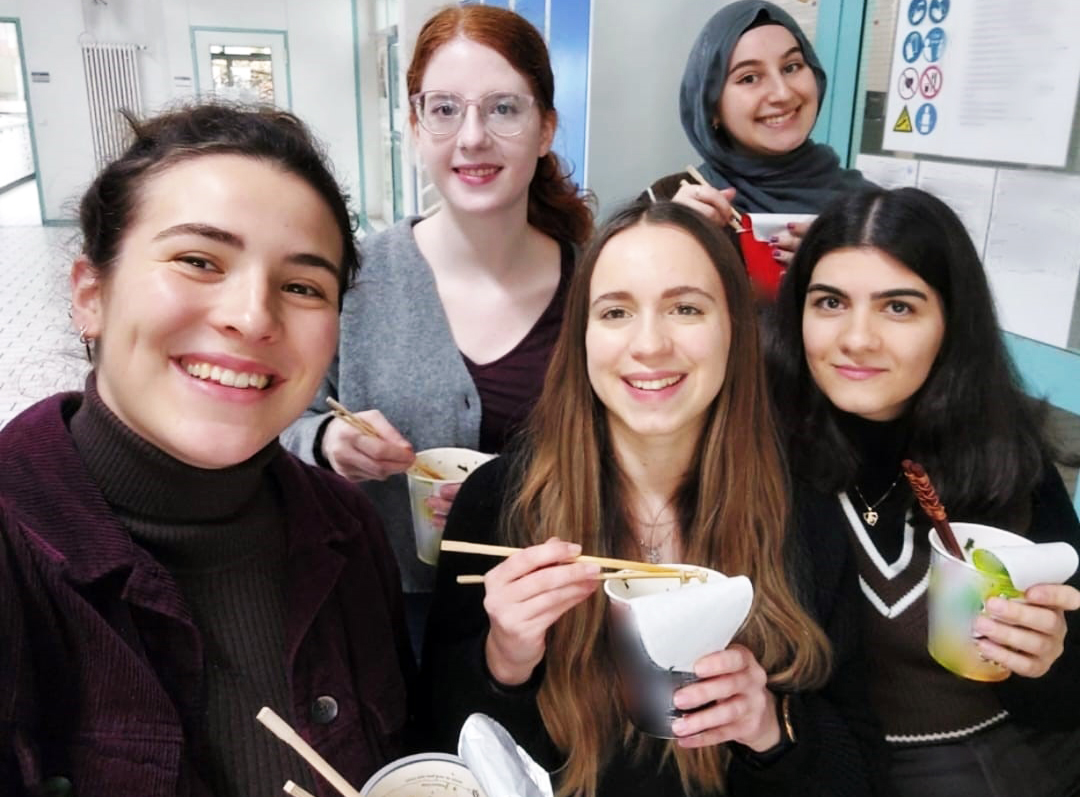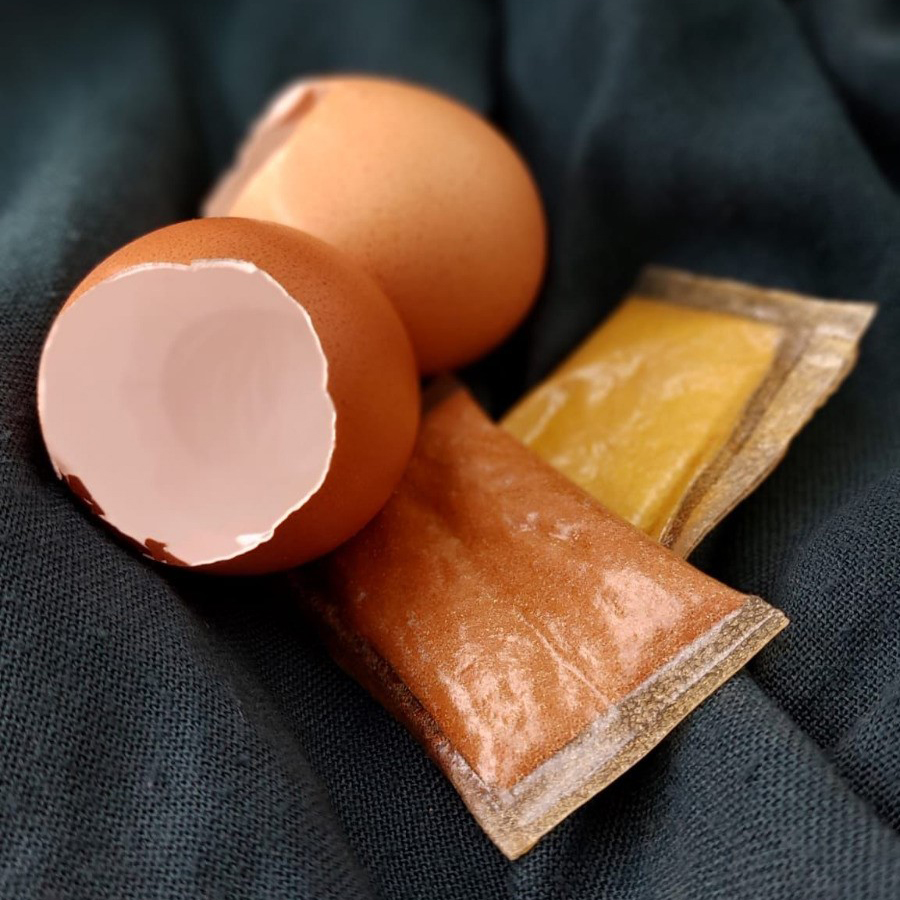Main navigation
EDGGY: edible packaging film made from eggshell waste
Many instant meals such as ramen soups have both a protective outer packaging and individual ingredients in small plastic sachets. To prevent this environmentally harmful waste, five students at the University of Hohenheim have developed a sustainable film based on eggshells and plant proteins that dissolves in hot water and is edible.
Adequate packaging is essential to protect products during transport or from contamination. Packaging can be used to portion food and keep out light, oxygen and moisture. This significantly increases shelf life and reduces food waste. However, despite their fundamentally positive function, packaging materials should be used sparingly as most have a poor environmental footprint.
The European Institute of Innovation and Technology (EIT) recently ran a competition for students to develop new sustainable packaging. As part of this EIT Food Reuse2Repack Challenge, Alena Fries, Bahar Abrishamchi, Cora Schmetzer, Lina Obeidat and Paulina Welzenbach from the University of Hohenheim produced an edible film made from eggshells, plant proteins and water, which was awarded the prize for the most innovative product in Rome last November.
Numerous different aspects had to be taken into account

The road to success was very labour-intensive for the five students from the Institute of Food Science and Biotechnology, as they only had nine months to complete the entire process. "We started by doing some rather random research to determine what packaging materials are available, the issues that arise in packaging technology, and the social problems associated with packaging," Fries explains. As the all-female team had already decided they were going to develop a new material from food side-flows or waste, Obeidat suggested the use of eggshells early on. After convincing her colleagues that this was a good idea, the team first had to agree on the type of packaging, because each type of material serves a different product spectrum. They also had to take the university’s facilities into consideration, because there are no packaging institutes in Hohenheim and therefore the resources available were somewhat limited. In the end, the students decided to develop a film.
"But we didn't just want to replace a common plastic-based packaging material, we wanted to take our product even further," says Abrishamchi, describing the thought process. "We wanted it to be a real solution to a problem and not just a nice, innovative accessory to an existing product range." This aspiration is very much in line with the EIT competition, whose goal is to enable students to establish a start-up company in the long term. Accordingly, the technical demands for producing the product and, most importantly, where it can sensibly be used to add value are all issues that needed weighing up in advance.
Edible film with a simple composition
Taking all these factors into account, the team then started the experimental phase with a very tight timeframe of less than three months to develop the required prototype. Support was forthcoming from the Department of Food Material Science, led by Prof. Dr. Jochen Weiss, and the Department of Plant-based Foods, led by Prof. Dr. Mario Jekle. Both professors, along with Dr. Ahmed Fahmy and PhD student Malte Leible, gave the students access to resources, laboratories and equipment, shared their technical knowledge, asked the necessary critical questions throughout the process and helped the women build a network.

Starting with finely chopped eggshells, the team produced liquid mixtures by adding various components, which they then poured into a mould to form a thin film. After oven drying, the resulting films were analysed and the production process optimised. In the end, it was quite simple: the novel packaging consists only of eggshells, vegetable proteins, a binding agent and water. It is transparent and flexible, but still fairly tear-resistant and can be processed into sachets using a standard film sealer. But that’s not all: the film, which is less than 1 mm thick, is also water-soluble and safe to consume, as it contains only food-compatible ingredients.
One area of everyday use was quickly identified: the popular instant ramen soups. In addition to the dried noodles, the instant meal always contains small sachets filled with spices and other ingredients, which are usually made of environmentally harmful plastic. "Our packaging dissolves when hot water is added and also provides protein," says Welzenbach. "A sustainable alternative with added value." Although the plant proteins are not waste products, production of the innovative packaging is quite low in resources overall. The students also deliberately took this aspect into account during development and critically examined every step. The team’s name, EDGGY, makes this clear: it is a combination of cutting-EDGE research and the raw material EGGs.
"However, at the moment our film is only suitable for dry products and cannot be used as outer packaging," explains Schmetzer. "This would be possible in principle, but we still have a lot of research to do, especially for outer packaging that is handled a lot and therefore has to meet even higher stability and impermeability standards."
Professional competence was not the only decisive factor
As the teams were put together by the competition organisers, the five students did not know each other beforehand, so the challenge required not only technical knowledge but also a high degree of social competence. "We were very lucky and we all get along well. We’re all very team-oriented and have our own individual strengths. We communicate well with each other and have always found productive solutions in joint discussions, which everyone then supported." It was also helpful that Welzenbach had learned the basics of business administration in her bachelor's degree at the Weihenstephan-Triesdorf University of Applied Sciences. And Abrishamchi, who came to Hohenheim from Iran to study for her master's degree, often brought a different perspective to discussions.
The journey from idea to functional product was very enriching for the group. "We quickly realised that not everything that is theoretically possible can be put into practice," says Obeidat describing the process. "Even producing a product that seems simple at first glance requires a lot of effort," adds Abrishamchi.
At the moment, all five students are busy with their master's theses, but can imagine developing their product further in the longer term and possibly even establishing a start-up company. "The positive feedback from the experts has made us incredibly happy and motivates us a lot. We have already received enquiries from manufacturers," Schmetzer explains.
The EDGGY team is currently taking part in the Bio-based Innovation Student Challenge - Europe (BISC-E) and won second place in the German qualifying round with their film. So the success story continues and will hopefully soon be on supermarket shelves.